2010122弹性力学(中英文)(2011)
- 格式:doc
- 大小:91.50 KB
- 文档页数:11
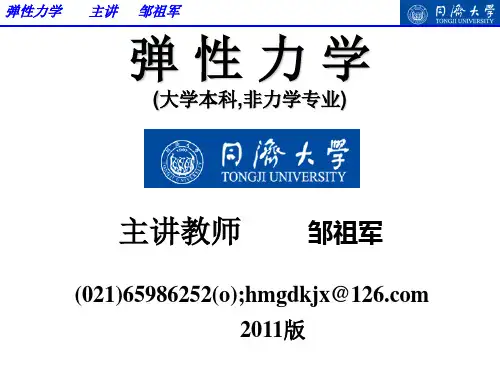
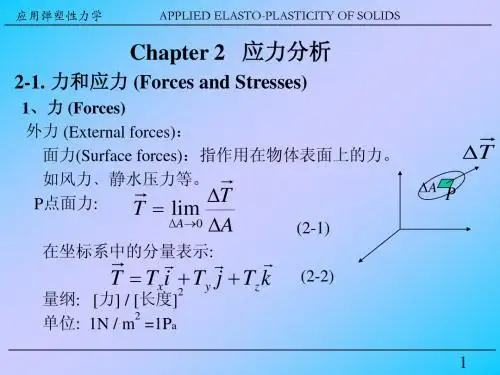


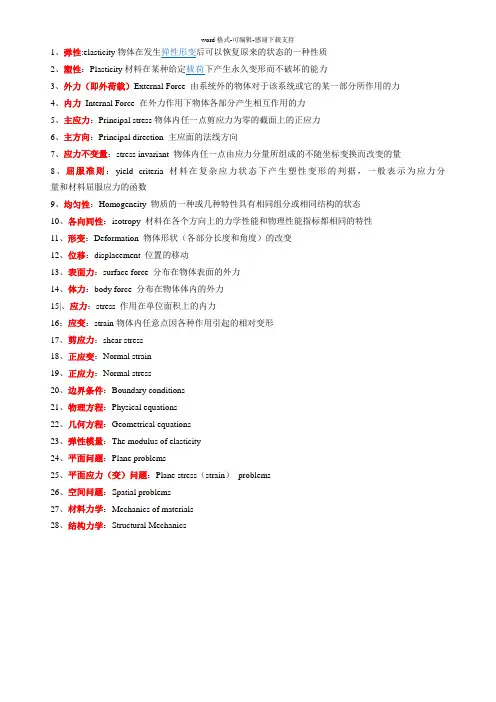
word格式-可编辑-感谢下载支持1、弹性:elasticity2、塑性:Plasticity3、外力(即外荷载)External Force 由系统外的物体对于该系统或它的某一部分所作用的力4、内力Internal Force 在外力作用下物体各部分产生相互作用的力5、主应力:Principal stress物体内任一点剪应力为零的截面上的正应力6、主方向:Principal direction 主应面的法线方向7、应力不变量:stress invariant 物体内任一点由应力分量所组成的不随坐标变换而改变的量8、屈服准则:yield criteria 材料在复杂应力状态下产生塑性变形的判据,一般表示为应力分量和材料屈服应力的函数9、均匀性:Homogeneity 物质的一种或几种特性具有相同组分或相同结构的状态10、各向同性:isotropy 材料在各个方向上的力学性能和物理性能指标都相同的特性11、形变:Deformation 物体形状(各部分长度和角度)的改变12、位移:displacement 位置的移动13、表面力:surface force 分布在物体表面的外力14、体力:body force 分布在物体体内的外力15|、应力:stress 作用在单位面积上的内力16:应变:strain物体内任意点因各种作用引起的相对变形17、剪应力:shear stress18、正应变:Normal strain19、正应力:Normal stress20、边界条件:Boundary conditions21、物理方程:Physical equations22、几何方程:Geometrical equations23、弹性模量:The modulus of elasticity24、平面问题:Plane problems25、平面应力(变)问题:Plane stress(strain)problems26、空间问题:Spatial problems27、材料力学:Mechanics of materials28、结构力学:Structural Mechanics。
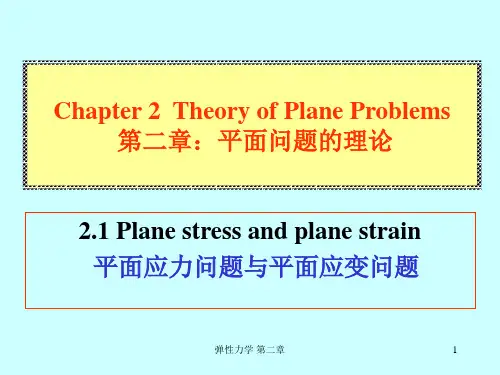



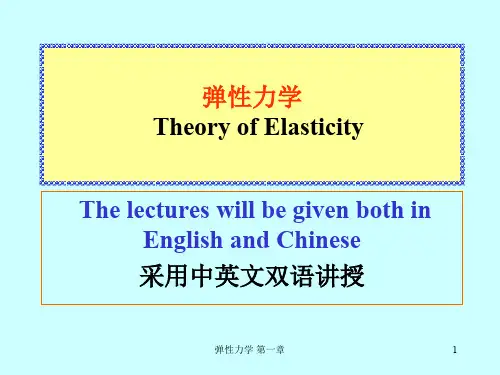

天津大学《弹性力学》课程教学大纲课程编号:2010122 课程名称:弹性力学学时:96 学分: 6学时分配:授课:96 上机:0 实验: 0 实践: 0 实践(周) 0授课学院:机械工程学院适用专业:工程力学先修课程:高等数学,材料力学,张量分析和场论一、课程的性质与目的弹性力学是固体力学学科的分支。
该课程是研究和分析工程结构和材料强度和学习《有限元法》、《塑性力学》、《断裂力学》等后续课程的理论基础。
课程的基本任务是研究弹性体在外载荷作用下,物体内部产生的位移、变形和应力分布规律,为解决工程结构和材料的强度、刚度和稳定性等问题提供解决思路和方法。
二、教学基本要求要求学生对应力、应变等基本概念有较深入的理解,掌握弹性力学解决问题的思路和方法。
能够系统地掌握弹性力学的基本理论、边值问题的提法和求解、弹性力学平面问题、柱形杆的扭转和能量原理,了解空间问题、复变函数解法、热应力和弹性波等。
三、教学内容弹性力学I1.绪论1.1弹性力学的任务、内容和研究方法1.2弹性力学的发展简史和工程应用1.3弹性力学的基本假设和载荷分类2.应力理论2.1内力和应力2.2斜面应力公式2.3应力分量转换公式2.4主应力,应力不变量2.5最大剪应力,八面体剪应力2.6应力偏量2.7应力平衡微分方程2.8正交曲线坐标系中的平衡方程3.应变理论3.1位移和应变3.2小应变张量3.3刚体转动3.4应变协调方程3.5位移单值条件3.6由应变求位移3.7正交曲线坐标系中的几何方程4.本构关系4.1广义胡克定律4.2应变能和应变余能4.3热弹性本构关系4.4应变能正定性5.弹性理论的微分提法、解法及一般原理5.1弹性力学问题的微分提法5.2位移解法5.3应力解法5.4应力函数解法5.5迭加原理5.6解的唯一性原理5.7圣维南原理6.柱形杆问题6.1问题的提法,单拉和纯弯情况6.2柱形杆的自由扭转6.3反逆法与半逆法,扭转问题解例6.4薄膜比拟6.5较复杂的扭转问题6.6柱形杆的一般弯曲7.平面问题7.1平面问题及其分类7.2平面问题的基本解法7.3应力函数的性质7.4直角坐标解例7.5极坐标中的平面问题7.6轴对称问题7.7非轴对称问题7.8关于解和解法的讨论弹性力学II8.复变函数解法8.1平面问题的复格式8.2单连域中复势的确定程度8.3多连域中复势的多值性8.4级数解法8.5保角变换解法8.6柯西积分公式的应用9.空间问题9.1齐次拉梅-纳维方程的一般解9.2非齐次拉梅-纳维方程的解9.3位移的势函数分解9.4空间轴对称问题9.5半空间问题9.6接触问题10.能量原理10.1基本概念和术语10.2可能功原理,功的互等定理10.3虚功原理和余虚功原理10.4最小势能原理和最小余能原理10.5弹性力学变分问题的欧拉方程10.6弹性力学变分问题的直接解法(一)10.7可变边界条件,卡氏定理10.8广义变分原理10.9弹性力学变分问题的直接解法(二)11.热应力11.1热传导基本概念11.2热弹性基本方程11.3热应力问题简例及不产生热应力的条件11.4基本方程的求解11.5平面热应力问题12.弹性波的传播12.1杆中的弹性波12.2无限介质中的弹性波12.3球面波12.4平面波12.5平面波的发射与折射12.6平面波在自由界面处的反射,瑞利波12.7勒夫波四、学时分配五、评价与考核方式平时成绩(出勤、作业等)20%,期末考试成绩80%。
大学《弹性力学》课程教学大纲课程编号:2010122 课程名称:弹性力学学时:96 学分: 6学时分配:授课:96 上机:0 实验:0 实践:0 实践(周)0授课学院:机械工程学院适用专业:工程力学先修课程:高等数学,材料力学,量分析和场论一、课程的性质与目的弹性力学是固体力学学科的分支。
该课程是研究和分析工程结构和材料强度和学习《有限元法》、《塑性力学》、《断裂力学》等后续课程的理论基础。
课程的基本任务是研究弹性体在外载荷作用下,物体部产生的位移、变形和应力分布规律,为解决工程结构和材料的强度、刚度和稳定性等问题提供解决思路和方法。
二、教学基本要求要求学生对应力、应变等基本概念有较深入的理解,掌握弹性力学解决问题的思路和方法。
能够系统地掌握弹性力学的基本理论、边值问题的提法和求解、弹性力学平面问题、柱形杆的扭转和能量原理,了解空间问题、复变函数解法、热应力和弹性波等。
三、教学容弹性力学I1.绪论1.1弹性力学的任务、容和研究方法1.2弹性力学的发展简史和工程应用1.3弹性力学的基本假设和载荷分类2.应力理论2.1力和应力2.2斜面应力公式2.3应力分量转换公式2.4主应力,应力不变量2.5最大剪应力,八面体剪应力2.6应力偏量2.7应力平衡微分方程2.8正交曲线坐标系中的平衡方程3.应变理论3.1位移和应变3.2小应变量3.3刚体转动3.4应变协调方程3.5位移单值条件3.6由应变求位移3.7正交曲线坐标系中的几何方程4.本构关系4.1广义胡克定律4.2应变能和应变余能4.3热弹性本构关系4.4应变能正定性5.弹性理论的微分提法、解法及一般原理5.1弹性力学问题的微分提法5.2位移解法5.3应力解法5.4应力函数解法5.5迭加原理5.6解的唯一性原理5.7圣维南原理6.柱形杆问题6.1问题的提法,单拉和纯弯情况6.2柱形杆的自由扭转6.3反逆法与半逆法,扭转问题解例6.4薄膜比拟6.5较复杂的扭转问题6.6柱形杆的一般弯曲7.平面问题7.1平面问题及其分类7.2平面问题的基本解法7.3应力函数的性质7.4直角坐标解例7.5极坐标中的平面问题7.6轴对称问题7.7非轴对称问题7.8关于解和解法的讨论弹性力学II8.复变函数解法8.1平面问题的复格式8.2单连域中复势的确定程度8.3多连域中复势的多值性8.4级数解法8.5保角变换解法8.6柯西积分公式的应用9.空间问题9.1齐次拉梅-纳维方程的一般解9.2非齐次拉梅-纳维方程的解9.3位移的势函数分解9.4空间轴对称问题9.5半空间问题9.6接触问题10.能量原理10.1基本概念和术语10.2可能功原理,功的互等定理10.3虚功原理和余虚功原理10.4最小势能原理和最小余能原理10.5弹性力学变分问题的欧拉方程10.6弹性力学变分问题的直接解法(一)10.7可变边界条件,卡氏定理10.8广义变分原理10.9弹性力学变分问题的直接解法(二)11.热应力11.1热传导基本概念11.2热弹性基本方程11.3热应力问题简例及不产生热应力的条件11.4基本方程的求解11.5平面热应力问题12.弹性波的传播12.1杆中的弹性波12.2无限介质中的弹性波12.3球面波12.4平面波12.5平面波的发射与折射12.6平面波在自由界面处的反射,瑞利波12.7勒夫波四、学时分配五、评价与考核方式平时成绩(出勤、作业等)20%,期末考试成绩80%。
六、教材与主要参考资料教材: 《弹性力学》,陆明万、罗学富著,清华大学,2001主要参考资料:《弹性理论》,王龙甫,科学,1978年;《弹性力学教程》,王敏中,王炜,武际可,大学,2002年;TU Syllabus for Elasticity TheoryCode: 2010122 Title: Elasticity Theory Semester Hours: 96 Credits: 6Semester Hour Structure Lecture:96 Computer Lab:0 Experiment:0 Practice:0Practice (Week):0Offered by: Mechanical Engineering Schoolfor: Engineering MechanicsPrerequisite: Higher mathematics, Material mechanics, Tensor analysis and field theory1.ObjectiveStudents should proficiently master of the basic concepts such as stress and strain and the basic theory of elasticity. They should master the presenting and solving of the elastic mechanics problems, plane problem, prismatic bar problems, plane problems and energy principles. In addition, they should know the theories about the space problems, thermal stress and elastic wave.2. Course DescriptionElasticity Theory is one of branches of solid mechanics. This course is a theoretical foundation to study and analyze the strength of engineering structures and materials and study the courses such as Finite Element Method, Plasticity Mechanics and Fracture Mechanics. This course mainly study the deformation and stress distribution in the elastic body under loadings. It provides the solving method for the strength, stiffness and stability problems for engineering materials and structures.3. TopicsElasticity I1.Introduction1.1 Object, contents and study method of theory of elasticity1.2 Development history and applications in engineering areas1.3 Basic assumptions and classifying of loadings2.Stress theory2.1 Internal forces and stress2.2 Surface tractions on a inclined section2.3 Transformation of stress components2.4 Principal stresses and stress invariant2.5 The maximal shearing stress, octahedral shear stress2.6 The stress deviation tensor2.7 Differential equations of equilibrium2.8 Differential equations of equilibrium in the orthogonal curvilinear coordinates 3.Strain theory3.1 Displacement and strain3.2 Infinitesimal strain tensor3.3 Rotation of rigid body3.4 Compatibility equation of strain3.5 Single-value condition of displacement fields3.6 To get the displacement from strain3.7 Geometrical equations in orthogonal curvilinear coordinates 4.Constitutive relations4.1 Generalized Hook law4.2 Strain energy and strain complementary energy4.3 Thermo-elastic constitutive relations4.4 The positive definiteness of the strain energy function5.Differential presentation of the elastic mechanics problems5.1 Differential presentation of the elastic mechanics problems5.2 Displacement solving method5.3 Stress solving method5.4 Stress functions solving method5.5 Superposition principle5.6 The uniqueness of solution5.7 Saint-Venant’s Principle6.Prismatic bar problems6.1 Problems presentation in the case of uniaxial tension and pure bending 6.2 Free twist of a prismatic bar6.3 Inverse method and semi-inverse method, examples of twisting problems 6.4 Membrane analogy6.5 Complicated twisting problem6.6 General bending of the prismatic bar7.Plane problems7.1 Plane problems and classification7.2 Basic solving method for plane problems7.3 properties of the stress functions7.4 Examples in rectangular coordinates7.5 Plane problems in polar coordinates7.6 Axisymmetric problems7.7 Non axisymmetric problems7.8 Discussions on the solutions and the solving methodsElasticity II8.Complex function method8.1 complex forms of plane problems8.2 complex potential in single connected domain8.3 multi-value of complex potential in multi-connected domain8.4 series method8.5 conformal transformation method8.6 applications of Cauchy integral formulations9.Three dimensional problems9.1 General solutions of L-N equations9.2 Solutions of the non-homogeneous L-N equations9.3 Decomposition of displacement potential function9.4 Three dimensional symmetrical problems9.5 Half space problems9.6 Contact problems10.Energy principle10.1 Basic concepts and terminology10.2 Possible work principle, reciprocal theorem10.3 Principle of virtual work and Principle of complementary virtual work10. 4 Principle of minimum potential energy and principle of minimum complementary energy10.5 Euler equations for the variational problems in elastic mechanics10.6 Direction solving method for the variational problems in elasticmechanics: I10.7 Moving boundary condition,Castigliano’s theorem10.8 Generalized variational problems10.9 Direction solving method for the variational problems in elasticmechanics: II11.Thermal stress11.1Concept of heat conduct11.2Basic equations of thermo-elasticity11.3Examples of thermal stress and condition of zero thermal stress11.4Solving of basic equations11.5Plane thermal stress problems12.Propagation of elastic wave12.1Elastic wave in bar12.2Elastic wave in infinite medium12.3Spherical wave12.4Plane wave12.5Reflection and refraction of elastic wave12.6Reflection of elastic wave at free interface and Rayleigh wave 12.7Love wave4. Semester Hour StructureRegular exam grade: 20%; Final exam grade: 80%.6. Text-Book & Additional Readings标准文案Text-Book: 《Elasticity Theory》by Lu M.W. and Luo X.F., Tsinghua University Press, 2001.Additional Readings:《Elasticity Theory》,by Wang L.F., Science Press,1978;《Textbook of Elasticity》by Wang M.Z, Wang W. and Wu J.K., Peking University Press, 2002.大全。